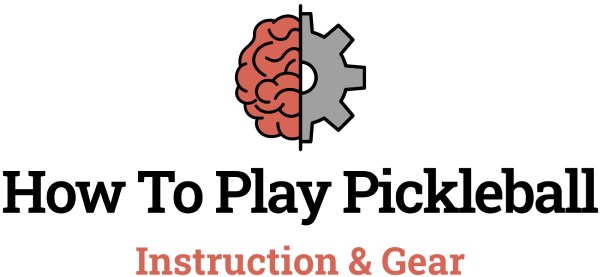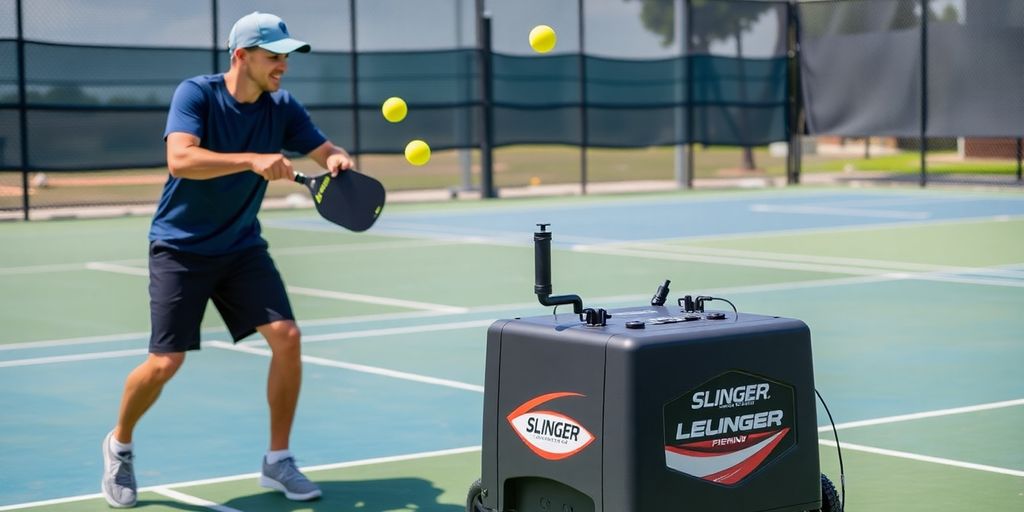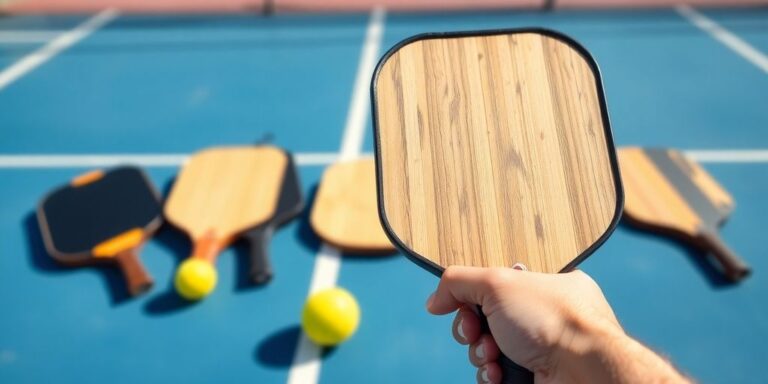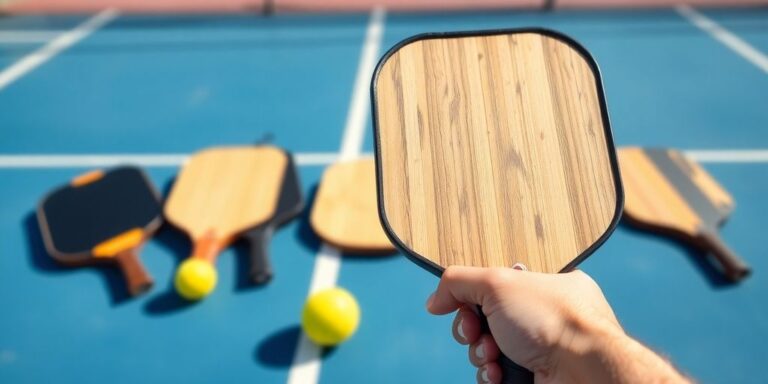If you’re looking to up your pickleball game, the Slinger Pickleball Machine might just be what you need. This innovative machine is designed to help players practice effectively, whether you’re a beginner or a seasoned pro. In this review, we’ll dive into what makes the Slinger stand out, how to make the most of it during your training sessions, and how it stacks up against other machines on the market. Get ready to discover if the Slinger is the right fit for your pickleball journey!
Key Takeaways
- The Slinger Pickleball Machine offers versatile ball placement for varied training.
- Its long battery life allows for extended practice sessions without frequent recharging.
- Portability is a standout feature, making it easy to transport to different courts.
- User-friendly design ensures that players of all levels can set it up and start practicing quickly.
- While it has some limitations, overall user feedback is positive, highlighting its value in training.
Understanding The Slinger Pickleball Machine
The Slinger Pickleball Machine is making waves in the pickleball community, and for good reason. It’s not just another piece of equipment; it’s a tool designed to help you level up your game. Let’s break down what makes this machine tick, from its standout features to some potential drawbacks.
Key Features
The Slinger is packed with features aimed at making your training sessions more effective and convenient. One of its biggest selling points is its ability to deliver balls to various spots on the court, simulating real-game scenarios. Here’s a quick rundown:
- Variable Speed and Trajectory: Adjust the speed and angle to practice different shots.
- Adjustable Feed Rate: Control how often balls are launched, giving you time to recover between shots.
- Remote Control: Start, stop, and adjust settings without having to walk back to the machine. The rules of pickleball are important to know before you start training.
Cons
While the Slinger has a lot going for it, it’s not without its downsides. It’s important to consider these before making a purchase:
- Price: It’s an investment, and there are cheaper options available.
- Weight: While portable, it can be a bit heavy to lug around, especially for some people.
- Durability: The nylon exterior might be prone to wear and tear over time.
One thing to keep in mind is that while the Slinger is designed to be portable, its weight can be a factor for some users. Consider how often you’ll be transporting it and how far you’ll need to carry it. Also, while the nylon exterior looks nice, it might not be as durable as some other materials.
User Experience
So, what’s it actually like to use the Slinger? For the most part, users report a positive experience. The setup is relatively straightforward, and the remote control makes it easy to adjust settings on the fly. The variable speed and trajectory allow for a wide range of drills, and the adjustable feed rate lets you customize the intensity of your training sessions. However, some users have noted that the machine can be a bit noisy, and the battery life may not be as long as advertised. Make sure you have the right Engage Pickleball paddles to get the most out of your training.
Maximizing Your Training With The Slinger Pickleball Machine
The Slinger Pickleball Machine isn’t just about hitting balls; it’s about transforming your practice into a focused, effective, and even enjoyable experience. It’s about smart training, not just more training. Let’s explore how to get the most out of this machine.
Tips and Tricks for Optimum Usage
- Start slow, then build up. Don’t crank the speed and feed rate to maximum right away. Get comfortable with the machine’s rhythm and your own responses first. Gradually increase the difficulty as you improve.
- Mix up your shots. Don’t just stand there hitting forehands. Use the machine to practice backhands, volleys, overheads, and even serves. The more varied your practice, the better prepared you’ll be for real games. Consider the GoSports GS1 Pickleball Paddle Review to find the right paddle for your training needs.
- Focus on form. The machine provides consistent feeds, so you can concentrate on perfecting your technique. Pay attention to your grip, stance, swing path, and follow-through. Record yourself and compare it to videos of professional players.
The key to effective training with the Slinger is consistency and focus. Set specific goals for each session, track your progress, and adjust your training plan as needed. Don’t just mindlessly hit balls; think about what you’re trying to achieve and how you can improve.
Customizing Your Practice Sessions
The Slinger Pickleball Machine shines when you tailor it to your specific needs. Here’s how:
- Skill-Based Drills: If you’re working on dinking, set the machine to deliver short, soft shots near the net. For groundstrokes, increase the distance and speed. If you want to improve your reaction time, use faster feeds and vary the ball placement. You can even simulate game situations by programming the machine to deliver a specific sequence of shots.
- Weakness Targeting: Identify your weaknesses and design drills to address them. If you struggle with backhands, spend extra time practicing them. If you have trouble with overheads, set the machine to deliver high lobs. Don’t avoid your weaknesses; attack them head-on.
- Partner Drills: While the Slinger is great for solo practice, it can also be used with a partner. One person can feed balls to the other, or you can set up drills where you alternate hitting shots. This adds a social element to your training and allows you to practice communication and teamwork. Check out this guide on mastering pickleball in a two-player format.
Utilizing Storage Effectively
The Slinger isn’t just a ball machine; it’s also a convenient storage solution. Here’s how to make the most of it:
- Dedicated Compartments: Use the designated compartments for balls, paddles, towels, and other accessories. This keeps everything organized and easily accessible.
- Weight Distribution: Distribute the weight evenly to prevent the machine from tipping over. Place heavier items at the bottom and lighter items at the top.
- Regular Cleaning: Clean the storage compartments regularly to prevent dirt and debris from accumulating. This will help keep your equipment in good condition. Consider top pickleball machines for comparison.
Here’s a simple table to illustrate storage optimization:
| Item | Compartment | Quantity | Notes |
|---|---|---|---|
| Pickleballs | Main | 100+ | Evenly distributed |
| Paddles | Side | 2 | Securely fastened |
| Towel | Small | 1 | Folded neatly |
| Water Bottle | Side Pocket | 1 | Insulated to keep water cool |
| Extra Grips | Small | 2 | In a sealed bag to prevent drying out |
On-Court Performance Of The Slinger Pickleball Machine
The moment of truth, right? How does the Slinger actually perform when you get it out on the court? Does it live up to the hype? Let’s break it down.
Initial Impressions
Okay, so first off, getting the Slinger onto the court is pretty easy. It’s not feather-light, but it’s manageable. The initial impression is definitely positive; it looks like a serious piece of training equipment. It’s not some flimsy toy. Setting it up is straightforward, and you can tell it’s built to take a bit of a beating. I was able to quickly adjust the settings and start sending balls downrange. It’s a good feeling when you can get right to practicing without a ton of fuss. The Slinger Bag review I read mentioned how easy it was to set up, and I agree.
Playing Experience
This is where the Slinger really shines. It’s not just about feeding balls; it’s about simulating real game situations. You can adjust the speed, angle, and frequency to work on different shots. I spent a good hour just drilling dinks, then switched it up to practice my overhead slams. The remote control is super handy for making adjustments on the fly. No need to run back and forth to the machine. It really does feel like you’re playing against a real opponent, forcing you to react and move. I found that using quality pickleball balls made a big difference in consistency.
Real-Game Shot Simulation
Here’s where the Slinger can really help your game. It’s all about replicating those tricky shots you see in real matches. You can set it up to fire off lobs, forcing you to track the ball and get into position. Or you can crank up the speed and work on your reaction time for those fast volleys at the net. The key is to experiment with the settings and find what works best for your training needs. I even tried simulating some cross-court shots to work on my footwork. It’s not perfect, but it’s a heck of a lot better than just hitting against a wall. You can even use it to practice with the best pickleball nets at home.
One thing I’ve noticed is that consistent ball placement is key for effective training. If the machine is spitting out balls all over the place, it’s hard to develop a rhythm. So, take the time to fine-tune the settings and make sure you’re getting a consistent feed. This will help you build muscle memory and improve your overall game.
Here’s a quick breakdown of the shot types I practiced and the Slinger settings I used:
| Shot Type | Speed | Angle | Frequency |
|---|---|---|---|
| Dinks | Low | Low | Fast |
| Volleys | High | Medium | Medium |
| Lobs | Medium | High | Slow |
| Groundstrokes | Medium | Low | Medium |
What Sets The Slinger Pickleball Machine Apart?
The Slinger Pickleball Machine definitely has some things going for it that make it stand out from the crowd. It’s not just another ball machine; it tries to bring something unique to the table. Let’s break down what makes it different.
Portability and Design
One of the biggest things people talk about is how easy it is to move around. The Slinger is designed to be portable, kind of like a roller duffle bag. You can extend the handle and wheel it around. It weighs about 42lbs, which is okay for most people, but it’s still something to consider. Some other machines, like the Simon 2, are lighter, even with their metal builds. The outer shell is nylon, which looks nice, but might not be as durable or easy to clean as other materials. The rise of pickleball players is demanding more portable equipment.
Versatile Training Capabilities
This machine can really help you mix up your training. It can feed balls at different speeds and intervals, letting you work on a bunch of different shots. You can adjust the feed rate from 2 to 7 seconds. It’s all about making your practice more like a real game. The Slinger Bag’s ability to deliver flat balls mimics real-game scenarios, enhancing the authenticity and variety of your practice sessions.
User-Friendly Features
It’s designed to be pretty easy to use. The remote control lets you change the settings without having to walk over to the machine all the time. Plus, it has compartments for your gear and even a spot for your phone. The Pickleball Launcher is also designed with user-friendliness in mind.
The Slinger tries to be more than just a machine that spits out balls. It aims to be a convenient and versatile training partner that you can take anywhere. It’s got some cool features that set it apart, but it’s also important to think about things like durability and weight when you’re making your decision.
Comparing The Slinger Pickleball Machine To Other Models
Performance Against Competitors
When you’re looking at pickleball training machines, it’s easy to get lost in the options. The Slinger Pickleball Machine definitely has some strong points, but how does it stack up against the competition? One key difference lies in the build and intended use. Some machines, like the Simon X, are built with stainless steel and aluminum, aiming for top-tier durability and are often favored by pros or clubs. The Slinger, on the other hand, uses nylon and plastic, which helps keep the cost down and makes it more portable, but might not hold up as well under heavy use. The firing wheels are made of polyurethane, which is great for handling different weather conditions and resisting wear and tear.
Price Point Analysis
Price is always a factor, right? The Slinger generally comes in at a more budget-friendly price compared to some of the higher-end models like the Simon X. But you get what you pay for. The Simon X justifies its higher cost with a lifetime warranty and more advanced features. If you’re just starting out or need something for occasional practice, the Slinger is a solid choice. But if you’re a serious player or coach looking for something that will last and offer more advanced training options, you might want to consider investing more. Here’s a quick comparison:
| Feature | Slinger Pickleball Machine | Simon X Pickleball Machine |
|---|---|---|
| Price | Lower | Higher |
| Build Quality | Nylon/Plastic | Stainless Steel/Aluminum |
| Warranty | Limited | Lifetime |
| Portability | High | Moderate |
| Intended Use | Beginner/Intermediate | Advanced/Professional |
User Feedback and Reviews
User reviews can really give you a feel for how a product performs in the real world. The Slinger generally gets good marks for being easy to use and portable. People like that it’s easy to set up and move around. However, some users have noted that the nylon construction might not be as durable as other machines. On the other hand, machines like the Simon X often get praised for their robust build and advanced features, but some users find them less portable. Ultimately, it comes down to what you prioritize in a pickleball machine.
Maintenance And Care For The Slinger Pickleball Machine

Cleaning and Upkeep
Keeping your Slinger Pickleball Machine in good shape is pretty straightforward. Because the outer shell is nylon, it can get dirty. I’ve found that a soft brush and a little bit of mild soap and water work wonders. Just make sure it’s completely dry before you pack it up. Regular cleaning prevents buildup that could affect performance.
Here’s a quick rundown:
- Wipe down the exterior after each use.
- Check the firing wheels for debris regularly.
- Store it in a dry place to prevent mold or mildew.
Battery Management
Battery life is key, right? To keep your Slinger running strong, avoid letting the battery sit completely drained for extended periods. I try to charge it after every couple of uses, even if it’s not fully depleted. This seems to help maintain its overall lifespan. Also, use the charger that came with the machine; using a different one could cause problems. You can find more maintenance tips on the Slinger website.
- Charge after every few uses.
- Use the original charger.
- Avoid extreme temperatures during charging and storage.
Storage Recommendations
Where you store your Slinger can really impact how long it lasts. I always make sure mine is stored indoors, away from direct sunlight and extreme temperatures. A garage or shed is fine, as long as it’s relatively dry and temperature-controlled. Also, I try not to stack heavy stuff on top of it, just to prevent any potential damage to the frame. Proper storage is key to pickleball gear longevity.
Storing your Slinger Pickleball Machine properly is more than just tucking it away; it’s about protecting your investment. Think of it like this: a little care now can save you from big headaches (and expenses) later. Keep it clean, keep it charged, and keep it stored right, and you’ll be enjoying those practice sessions for a long time to come.
Future Innovations In Pickleball Training Technology

Emerging Trends
The world of pickleball is changing fast, and that includes how we train. Forget just hitting against a wall – we’re talking about some serious tech upgrades. One of the biggest trends is the use of data analytics to track player performance. Imagine sensors in your paddle or on the court that tell you everything about your swing, your speed, and your shot placement. This data can then be used to create personalized training plans that target your specific weaknesses and help you enhance your pickleball skills quickly.
- Wearable sensors for real-time feedback.
- AI-powered coaching apps.
- Smart courts that track ball movement and player positioning.
Potential Upgrades for The Slinger
The Slinger is already a great machine, but there’s always room for improvement. One thing I’d love to see is better integration with training apps. Imagine if the Slinger could automatically adjust its settings based on the data from your wearable sensor. Or what if it could learn your opponent’s tendencies and simulate their shots? That would be next level! Another area for improvement is portability. While the Slinger is relatively easy to move, it could be even lighter and more compact. Maybe even add some all-terrain wheels for those rougher court surfaces.
I think the future of pickleball training is all about personalization and convenience. Players want tools that are easy to use, that give them real-time feedback, and that can be customized to their individual needs. The Slinger has the potential to be a leader in this space, but it needs to keep innovating to stay ahead of the curve.
Here are some potential upgrades:
- Improved app integration with virtual reality training.
- Lighter and more durable materials.
- More advanced shot customization options.
Impact on Player Development
These new technologies are going to have a huge impact on how players develop their skills. No more guessing about what you need to work on – the data will tell you exactly where you need to improve. And with personalized training plans, you’ll be able to make progress much faster. I also think these technologies will make training more fun and engaging. Who wouldn’t want to see how their stats stack up against the pros? Plus, the ability to integrate 3D printing into paddle design could lead to even more customized equipment and better performance. It’s an exciting time to be a pickleball player!
| Feature | Benefit |
|---|---|
| Data Analytics | Personalized training, faster improvement |
| VR Training | Immersive practice, realistic simulations |
| Smart Equipment | Customized gear, enhanced performance |
As pickleball continues to grow, new training tools are emerging to help players improve their skills. From smart paddles that track your swings to apps that analyze your game, the future of pickleball training is exciting! Want to stay ahead of the game? Visit our website for the latest innovations and tips to enhance your pickleball experience!
Final Thoughts on the Slinger Pickleball Machine
In conclusion, the Slinger Pickleball Machine is a solid choice for anyone looking to up their game. It’s packed with features that make practice easier and more effective. Sure, there are a few things to think about, like its weight and some minor setup quirks, but overall, it gets the job done. Whether you’re just starting out or you’ve been playing for years, this machine can help you improve. By using it wisely and following some simple tips, you can really make the most of your training sessions. So, if you’re serious about pickleball, the Slinger Bag might just be the training partner you need.
Frequently Asked Questions
What is the Slinger Pickleball Machine used for?
The Slinger Pickleball Machine is designed to help players practice their pickleball skills by launching balls at different speeds and angles.
Is the Slinger Pickleball Machine easy to transport?
Yes, it is lightweight and has a design similar to a roller bag, making it easy to carry to different locations.
How long does the battery last on the Slinger Machine?
The battery can last up to 3 hours, allowing for extended practice sessions without needing to recharge.
Can I adjust the settings on the Slinger Pickleball Machine?
Absolutely! You can customize the speed, spin, and height of the balls to match your training needs.
Is the Slinger Machine suitable for beginners?
Yes, it is user-friendly and perfect for players of all skill levels, including beginners.
What should I do to maintain the Slinger Pickleball Machine?
Regularly clean it, manage the battery properly, and store it in a safe place to keep it in good condition.




